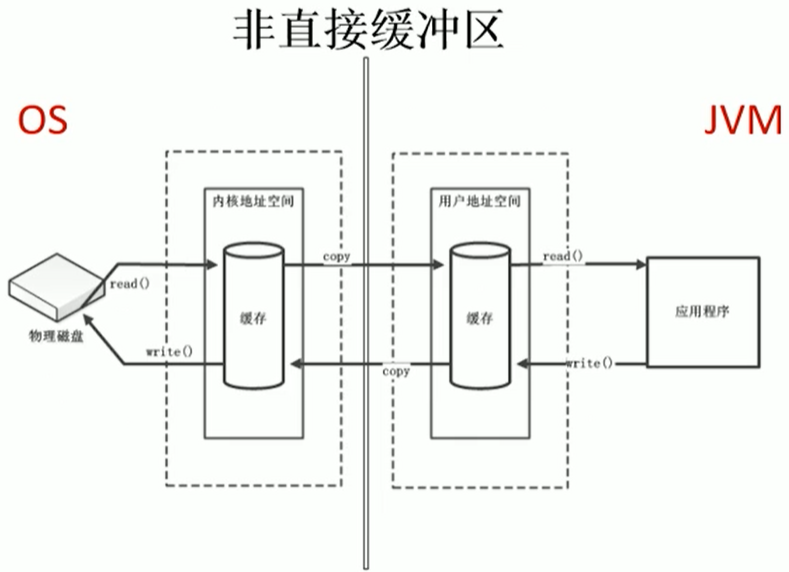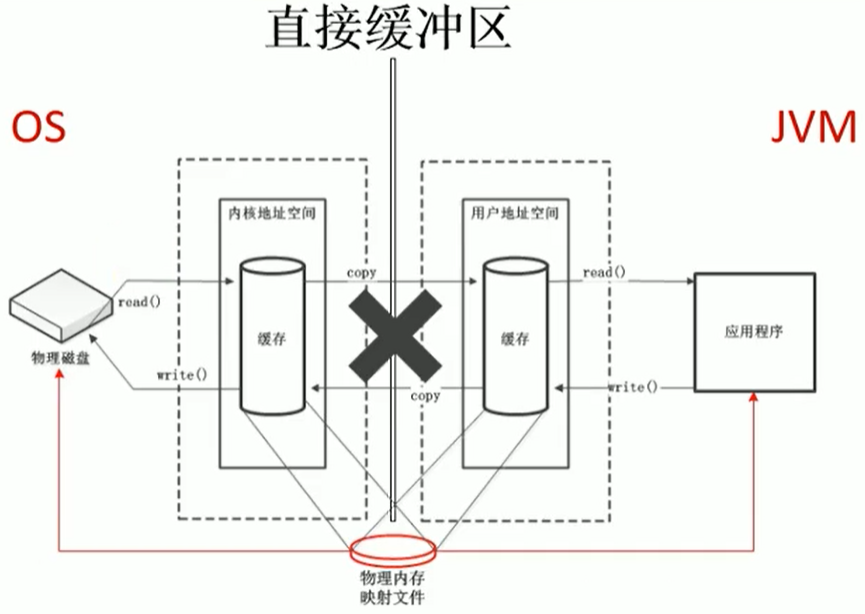10.1 📖 概述
💬说明
直接内存不是虚拟机运行时数据区的一部分,也不是《Java虚拟机规范》中定义的内存区域。
直接内存是在Java堆外的,直接向系统申请的内存区间。
来源于NIO,通过存在堆中的DirectByteBuffer操作Native内存。
⚙️设置
- 直接内存大小可以通过MaxDirectMemorySize设置
- 如果不指定,默认与堆的最大值-Xmx参数值一致
🌠特点
通常,访问直接内存的速度会优于Java堆,即读写性能高。
- 因此出于性能考虑,读写频繁的场合可能会考虑使用直接内存。
- Java的NIO库允许Java程序使用直接内存,用于数据缓冲区。
⌨️示例
使用下列代码,直接分配本地内存空间
public class BufferTest {private static final int BUFFER = 1024 * 1024 * 1024;public static void main(String[] args) {ByteBuffer byteBuffer = ByteBuffer.allocate(BUFFER);System.out.println("直接内存分配完毕");Scanner scanner = new Scanner(System.in);scanner.next();System.out.println("直接内存开始释放");byteBuffer = null;System.gc();}}
运行之后可以看到进程已分配内存:

10.2 🌀 非直接缓冲区和缓冲区
🟣非直接缓冲区
读写文件,需要与磁盘交互,需要由用户态切换到内核。在内核态时,需要内存如下图的操作。
需要两份内存存储重复数据,效率低。

🟠直接缓冲区
使用NIO时,如下图。
操作系统划出的直接缓存区可以被Java代码直接访问,只有一份。
NIO适合对大文件的读写操作。

⌨️测试案例
分别使用BIO和NIO进行复制复联四电影文件(3.74GB):
public class CopyFileTest {private static final String MOVIE_NAME = "D:/BaiduNetdiskDownload/复仇者联盟4-终局之战.mp4";private static final int ONE_HUNDRED_MB = 1024 * 1024 * 100;public static void main(String[] args) throws IOException {System.out.println("BIO耗时:" + inDirectBuffer(MOVIE_NAME, MOVIE_NAME + ".copy.mp4"));System.out.println("NIO耗时:" + directBuffer(MOVIE_NAME, MOVIE_NAME+ ".copy.mp4"));}/*** BIO复制*/private static long inDirectBuffer(String src, String dest) throws IOException{long start = System.currentTimeMillis();FileInputStream inputStream = new FileInputStream(src);FileOutputStream outputStream = new FileOutputStream(dest);byte[] buffer = new byte[ONE_HUNDRED_MB];int len = 0;while ((len = inputStream.read(buffer)) != -1) {outputStream.write(buffer, 0, len);}long end = System.currentTimeMillis();inputStream.close();outputStream.close();return end - start;}/*** NIO复制*/private static long directBuffer(String src, String dest) throws IOException{long start = System.currentTimeMillis();FileChannel inChannel = new FileInputStream(src).getChannel();FileChannel outChannel = new FileOutputStream(dest).getChannel();ByteBuffer byteBuffer = ByteBuffer.allocate(ONE_HUNDRED_MB);while (inChannel.read(byteBuffer) != -1) {byteBuffer.flip();outChannel.write(byteBuffer);byteBuffer.clear();}long end = System.currentTimeMillis();inChannel.close();outChannel.close();return end - start;}}
运行结果:
BIO耗时:11946NIO耗时:9079
10.3 💢 存在的问题
🔺问题
- 也可能导致OutOfMemoryError异常。
- 由于直接内存在Java堆外,因此它的大小不会直接受限于-Xmx指定的最大堆大小,但是系统内存是有限的,Java堆和直接内存的总和依然受限于操作系统能给出的最大内存。
🔻缺点
- 分配回收成本高。
- 不受JVM内存回收管理。
💌总结
java process memory = java heap + native memory
进程内存空间 = 堆空间 + 本地内存

